narrative poetry
- 格式:docx
- 大小:14.02 KB
- 文档页数:3
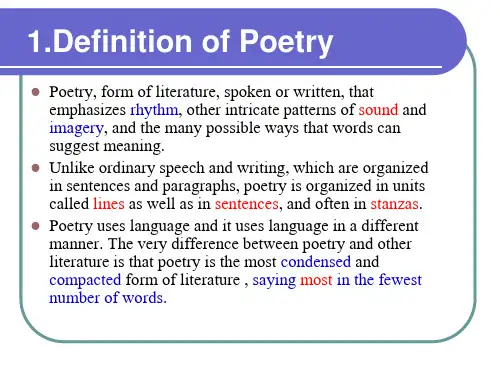
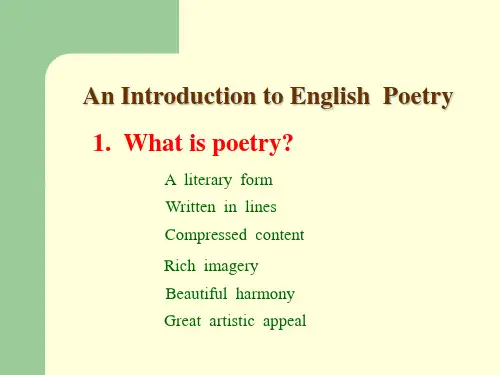
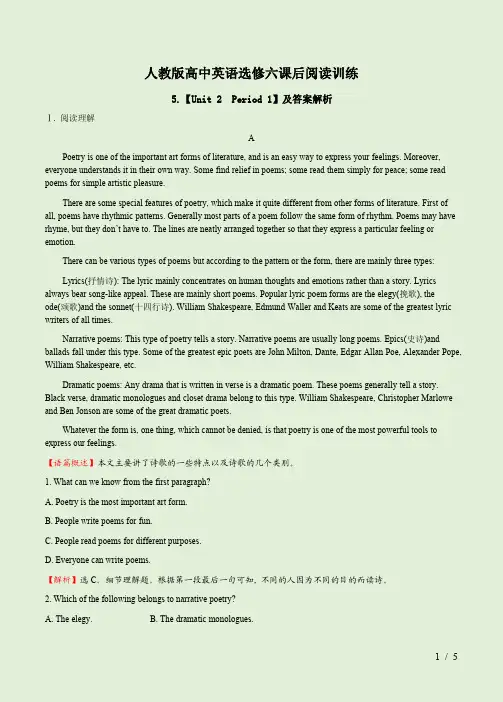
人教版高中英语选修六课后阅读训练5.【Unit2Period1】及答案解析Ⅰ.阅读理解APoetry is one of the important art forms of literature,and is an easy way to express your feelings.Moreover, everyone understands it in their own way.Some find relief in poems;some read them simply for peace;some read poems for simple artistic pleasure.There are some special features of poetry,which make it quite different from other forms of literature.First of all,poems have rhythmic patterns.Generally most parts of a poem follow the same form of rhythm.Poems may have rhyme,but they don’t have to.The lines are neatly arranged together so that they express a particular feeling or emotion.There can be various types of poems but according to the pattern or the form,there are mainly three types:Lyrics(抒情诗):The lyric mainly concentrates on human thoughts and emotions rather than a story.Lyrics always bear song-like appeal.These are mainly short poems.Popular lyric poem forms are the elegy(挽歌),theode(颂歌)and the sonnet(十四行诗).William Shakespeare,Edmund Waller and Keats are some of the greatest lyric writers of all times.Narrative poems:This type of poetry tells a story.Narrative poems are usually long poems.Epics(史诗)and ballads fall under this type.Some of the greatest epic poets are John Milton,Dante,Edgar Allan Poe,Alexander Pope, William Shakespeare,etc.Dramatic poems:Any drama that is written in verse is a dramatic poem.These poems generally tell a story. Black verse,dramatic monologues and closet drama belong to this type.William Shakespeare,Christopher Marlowe and Ben Jonson are some of the great dramatic poets.Whatever the form is,one thing,which cannot be denied,is that poetry is one of the most powerful tools to express our feelings.【语篇概述】本文主要讲了诗歌的一些特点以及诗歌的几个类别。
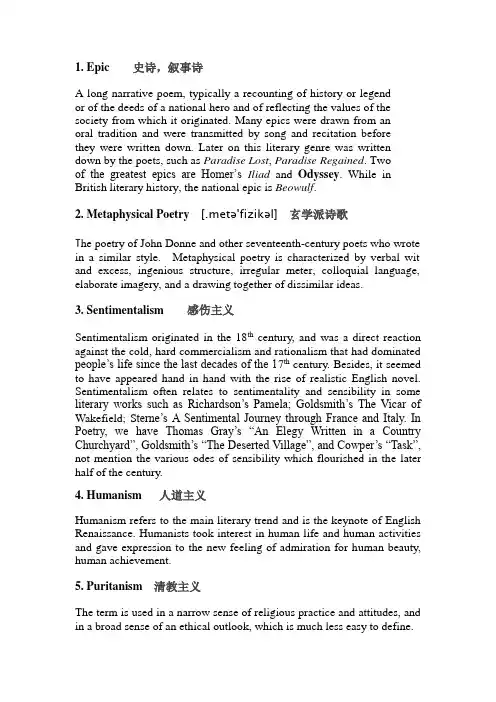
1. Epic 史诗,叙事诗A long narrative poem, typically a recounting of history or legendor of the deeds of a national hero and of reflecting the values of the society from which it originated. Many epics were drawn from anoral tradition and were transmitted by song and recitation beforethey were written down. Later on this literary genre was written down by the poets, such as Paradise Lost, Paradise Regained. Twoof the greatest epics are Homer’s Iliad and Odyssey. While in British literary history, the national epic is Beowulf.2. Metaphysical Poetry [.metə'fizikəl]玄学派诗歌T he poetry of John Donne and other seventeenth-century poets who wrote in a similar style. Metaphysical poetry is characterized by verbal wit and excess, ingenious structure, irregular meter, colloquial language, elaborate imagery, and a drawing together of dissimilar ideas.3. Sentimentalism 感伤主义Sentimentalism originated in the 18th century, and was a direct reaction against the cold, hard commercialism and rationalism that had dominated people’s life since the last decades of the 17th century. Besides, it seemed to have appeared hand in hand with the rise of realistic English novel. Sentimentalism often relates to sentimentality and sensibility in some literary works such as Richardson’s Pamela; Goldsmith’s The Vicar of Wakefield; S terne’s A Sentimental Journey through France and Italy. In Poetry, we have Thomas Gray’s “An Elegy Written in a Country Churchyard”, Goldsmith’s “The Deserted Village”, and Cowper’s “Task”, not mention the various odes of sensibility which flourished in the later half of the century.4. Humanism 人道主义Humanism refers to the main literary trend and is the keynote of English Renaissance. Humanists took interest in human life and human activities and gave expression to the new feeling of admiration for human beauty, human achievement.5. Puritanism 清教主义The term is used in a narrow sense of religious practice and attitudes, and in a broad sense of an ethical outlook, which is much less easy to define.1). In its strict sense, “Puritan” was applied to tho se Protestant reformers who rejected Queen Elizabeth’s religious settlement of 1560. This settlement sought a middle way between Roman Catholicism and the extreme spirit of reform of Geneva. The Puritans, influenced by Geneva, Zurich, and other continental centers, objected to the retention of bishops and to any appearance of what they regarded as superstition in church worship---the wearing of vestments by the priests, and any kind of religious image. Apart from their united opposition to Roman Catholicism and their insistence on simplicity in religious forms, Puritans disagreed among themselves on questions of doctrine and church organization. Puritans were very strong in the first half of 17th century and reached its peak of power after the Civil War of 1642-6, a war, which was ostensibly religious, although it was also political.2). In the broad sense of a whole way of life, Puritanism has always represented strict obedience to the dictates of conscience and strong emphasis on the virtue of self-denial. The word “Puritan” is often thought to imply hostility to arts, but this is not necessarily true.6. Renaissance [rə'neisəns]文艺复兴It is a cultural movement of the rising bourgeoisie. The key word for it is humanism, which emphasizes the belief in human beings, his environment and doings and his brave fight for the emancipation of man from the tyranny of the church and religious dogmas. It originally indicates a revival of classical arts and learning after the dark ages of medieval obscurantism. Its aim is to get rid of those old feudalist ideas in medieval time and introduce new ideas that express the interests of the rising bourgeoisie. Shakespeare, Spenser, and Marlowe are all famous literary figures in this period.7.. Neo-classicism:新古典派A revival in the seventeenth and eighteenth centuries of classical standards of order, balance and harmony in literature. John Dryden was the first person who started the movement at the end of the 17th century, while Alexander Pope brought it to its culmination.8. Sentimentalism:Sentimentalism originated in the 18th century, and was a direct reaction against the cold, hard commercialism and rationalism that had dominatedpeople’s life since the last decades of the 17th century. Besides, it seemed to have appeared hand in hand with the rise of realistic English novel. Sentimentalism often relates to sentimentality and sensibility in some literary works such as Richardson’s Pamela; Goldsmith’s The Vicar of Wakefield; Sterne’s A Sentimental Journey t hrough France and Italy. In Poetry, we have Thomas Gray’s “An Elegy Written in a Country Churchyard”, Goldsmith’s “The Deserted Village”,not mention the various odes of sensibility which flourished in the later half of the century.9.Enlightenment:启蒙Enlightenment is a progressive intellectual movement, which sweptover England and other lands in Western Europe in the 18th century. Enlightenment freed and reformed the thinking of man. Enlighteners strove to clear away the feudal remnants and replace them by bourgeois ideologue.10. “Transcendentalism”[.trænsen'dentəlizəm]超验主义is defined as the recognition in man of the capacity of acquiring knowledge transcending the reach of the five senses, or of knowing truth intuitively, or of reaching the divine without the need of an intercessor. It was the first American intellectual movement. It stressed the power of intuition and the significance of the individual. It placed spirit first and matter second, and took nature as symbolic of God.11. Naturalism 自然主义Is a kind of social Darwinism, which holds that the weak and stupid would fall victim to economic forces. Literary naturalism holds that humans are controlled by laws of heredity and environment, and that the universe is cold and hostile to human desires. American naturalists wrote in a daring, open, and direct manner.12. Local Colorism: 本土特色地方色彩The local color writing was a form of regionalism popular after the Civil War. As a subordinate order of realism, regionalism (乡土主义,地方色彩) stresses a faithful representation of the habits, speech, manners, history, folklore, or beliefs of a particular geographical section. It’s characterized by vernacular language and satirical humor.13. Imagism: 意象主义It is a Movement in U.S. and English poetry characterized by the use of concrete language and figures of speech, modern subject matter, metrical freedom, and avoidance of romantic or mystical themes, aiming at clarity of expression through the use of precise visual images.It grew out of the Symbolist Movement in 1912 and was initially led by Ezra Pound, Amy Lowell, and others.14.Metaphysical: 玄学派诗歌或诗人的It refers to the school of poets that appeared in the Revolutionary period in England by using quite unconventional and often surprising conceits; the metaphysical poets wrote poems full of wits and humor. But sometimes the logic argument and conceits become persuasive, going to preposterous dimensions. The language is colloquial but very powerful, creating unorthodox images on the reader’s mind. John Donne is the representative metaphysical poets.15. Blank verse: 无韵诗,素体诗Blank verse is unrhymed poetry, typically in iambic pentameter, and, as such, the dominant verse form of English dramatic and narrative poetry since the mid-16th century. Blank verse is not written in stanza form. Instead, the poem is developed in verse paragraphs that vary in length. Blank verse is flexible form of expression that gives the poet a choice of many variations within the metrical pattern. Because of its flexibility, blank verse is especially appropriate for narrative and dramatic poetry and other longer kinds of poetry. Christopher Marlowe and Shakespeare used this form with great power and variety in their plays.16. Free verse: (不受格律约束的)自由诗体Free verse refers to a kind of poetry whose rhythmical lines vary in length, adhering to no fixed metrical pattern or the usually rhyming system, such poetry may seem formless, but it does have a form or pattern, often largely based on repetition and parallel structure. Walt Whitman’s poems are typical example.。
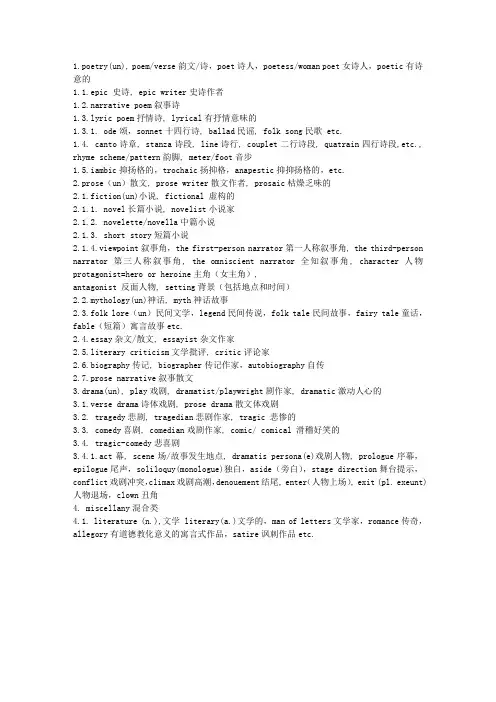
1.poetry(un), poem/verse韵文/诗,poet诗人,poetess/woman poet女诗人,poetic有诗意的1.1.epic 史诗, epic writer史诗作者1.2.narrative poem叙事诗1.3.lyric poem抒情诗, lyrical有抒情意味的1.3.1. ode颂,sonnet十四行诗, ballad民谣, folk song民歌 etc.1.4. canto诗章, stanza诗段, line诗行, couplet二行诗段, quatrain四行诗段,etc., rhyme scheme/pattern韵脚, meter/foot音步1.5.iambic抑扬格的,trochaic扬抑格,anapestic抑抑扬格的,etc.2.prose(un)散文, prose writer散文作者, prosaic枯燥乏味的2.1.fiction(un)小说, fictional 虚构的2.1.1. novel长篇小说, novelist小说家2.1.2. novelette/novella中篇小说2.1.3. short story短篇小说2.1.4.viewpoint叙事角,the first-person narrator第一人称叙事角, the third-person narrator第三人称叙事角, the omniscient narrator全知叙事角, character人物protagonist=hero or heroine主角(女主角),antagonist 反面人物, setting背景(包括地点和时间)2.2.mythology(un)神话, myth神话故事2.3.folk lore(un)民间文学,legend民间传说,folk tale民间故事,fairy tale童话,fable(短篇)寓言故事etc.2.4.essay杂文/散文, essayist杂文作家2.5.literary criticism文学批评, critic评论家2.6.biography传记, biographer传记作家,autobiography自传2.7.prose narrative叙事散文3.drama(un), play戏剧, dramatist/playwright剧作家, dramatic激动人心的3.1.verse drama诗体戏剧, prose drama散文体戏剧3.2. tragedy悲剧, tragedian悲剧作家, tragic 悲惨的3.3. comedy喜剧, comedian戏剧作家, comic/ comical 滑稽好笑的3.4. tragic-comedy悲喜剧3.4.1.act幕, scene场/故事发生地点, dramatis persona(e)戏剧人物, prologue序幕,epilogue尾声,soliloquy(monologue)独白,aside(旁白),stage direction舞台提示,conflict戏剧冲突,climax戏剧高潮,denouement结尾, enter(人物上场), exit (pl. exeunt)人物退场,clown丑角4. miscellany混合类4.1. literature (n.),文学 literary(a.)文学的,man of letters文学家,romance传奇,allegory有道德教化意义的寓言式作品,satire讽刺作品etc.。
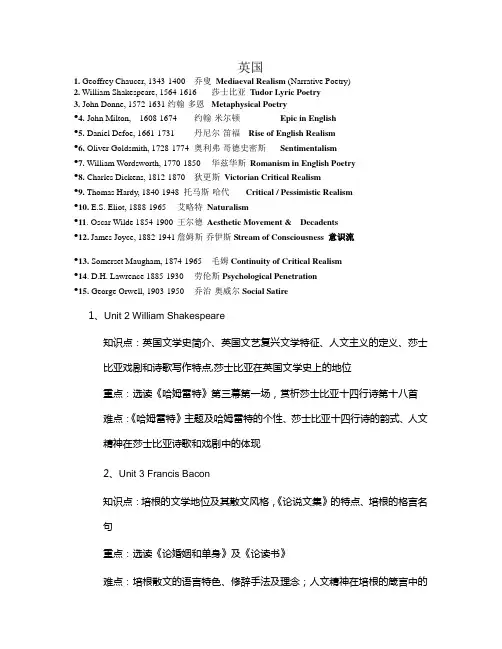
英国1. Geoffrey Chaucer, 1343-1400 乔叟Mediaeval Realism (Narrative Poetry)2. William Shakespeare, 1564-1616 莎士比亚T udor Lyric Poetry3. John Donne, 1572-1631约翰·多恩Metaphysical Poetry•4. John Milton, 1608-1674 约翰·米尔顿Epic in English•5. Daniel Defoe, 1661-1731 丹尼尔·笛福Rise of English Realism•6. Oliver Goldsmith, 1728-1774 奥利弗·哥德史密斯Sentimentalism•7. William Wordsworth, 1770-1850 华兹华斯Romanism in English Poetry•8. Charles Dickens, 1812-1870 狄更斯Victorian Critical Realism•9. Thomas Hardy, 1840-1948 托马斯·哈代Critical / Pessimistic Realism•10. E.S. Eliot, 1888-1965 艾略特Naturalism•11. Oscar Wilde 1854-1900 王尔德Aesthetic Movement & Decadents•12. James Joyce, 1882-1941 詹姆斯·乔伊斯Stream of Consciousness 意识流•13. Somerset Maugham, 1874-1965 毛姆Continuity of Critical Realism•14. D.H. Lawrence 1885-1930 劳伦斯Psychological Penetration•15. George Orwell, 1903-1950 乔治·奥威尔Social Satire1、Unit 2 William Shakespeare知识点:英国文学史简介、英国文艺复兴文学特征、人文主义的定义、莎士比亚戏剧和诗歌写作特点,莎士比亚在英国文学史上的地位重点:选读《哈姆雷特》第三幕第一场,赏析莎士比亚十四行诗第十八首难点:《哈姆雷特》主题及哈姆雷特的个性、莎士比亚十四行诗的韵式、人文精神在莎士比亚诗歌和戏剧中的体现2、Unit 3 Francis Bacon知识点:培根的文学地位及其散文风格,《论说文集》的特点、培根的格言名句重点:选读《论婚姻和单身》及《论读书》难点:培根散文的语言特色、修辞手法及理念;人文精神在培根的箴言中的体现3、Unit 4 17th-century British Poets知识点:十七世纪英国资产阶级革命及复辟时期社会背景、十七世纪英国文学特点、弥尔顿诗歌作品的文学特征重点:选读《失乐园》第一部难点:《失乐园》的文学特点、《失乐园》的修辞手法分析、“撒旦”形象分析、古希腊罗马文学和文艺复兴文学传统在《失乐园》中的体现4. Unit6 Romantic Poets(I)& Unit8 Romantic Poets(II)知识点:浪漫主义文学的特征、浪漫主义文学流派、浪漫主义诗歌特征及代表诗人、彭斯的诗歌风格、华兹华斯的诗歌特点、雪莱的诗歌成就、济慈的主要诗作的主题思想、语言风格、艺术特色。
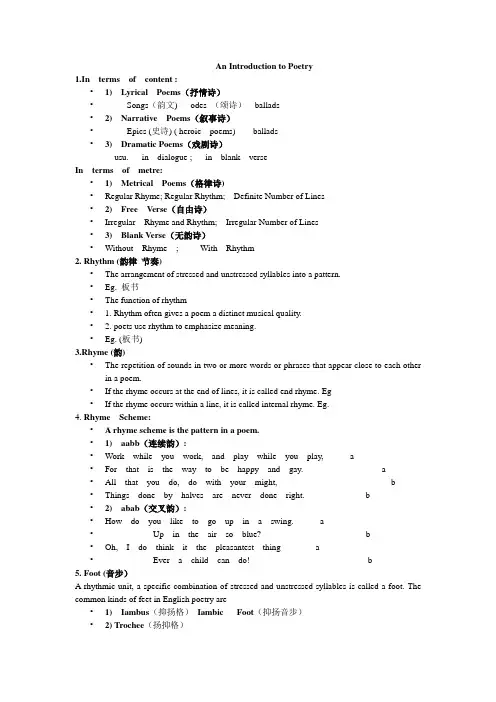
An Introduction to Poetry1.In terms of content :•1) Lyrical Poems(抒情诗)•Songs(韵文) odes (颂诗)ballads•2) Narrative Poems(叙事诗)•Epics (史诗) ( heroic poems) ballads•3) Dramatic Poems(戏剧诗)usu. in dialogue ; in blank verseIn terms of metre:•1) Metrical Poems(格律诗)•Regular Rhyme; Regular Rhythm; Definite Number of Lines•2) Free Verse(自由诗)•Irregular Rhyme and Rhythm; Irregular Number of Lines•3) Blank Verse(无韵诗)•Without Rhyme ; With Rhythm2. Rhythm (韵律节奏)•The arrangement of stressed and unstressed syllables into a pattern.•Eg. 板书•The function of rhythm• 1. Rhythm often gives a poem a distinct musical quality.• 2. poets use rhythm to emphasize meaning.•Eg. (板书)3.Rhyme (韵)•The repetition of sounds in two or more words or phrases that appear close to each other in a poem.•If the rhyme occurs at the end of lines, it is called end rhyme. Eg•If the rhyme occurs within a line, it is called internal rhyme. Eg.4. Rhyme Scheme:• A rhyme scheme is the pattern in a poem.•1) aabb(连续韵):•Work while you work, and play while you play, a•For that is the way to be happy and gay. a•All that you do, do with your might, b•Things done by halves are never done right. b•2) abab(交叉韵):•How do you like to go up in a swing. a•Up in the air so blue? b•Oh, I do think it the pleasantest thing a•Ever a child can do! b5. Foot (音步)A rhythmic unit, a specific combination of stressed and unstressed syllables is called a foot. The common kinds of feet in English poetry are•1) Iambus(抑扬格)Iambic Foot(抑扬音步)•2) Trochee(扬抑格)•3) Anapaest(抑抑扬格)•4) Dactyl(扬抑抑格)•5) Spondee(扬扬格)Eg.6. Metre (韵律)(格律)•The word metre means measure.the metre of a verse line is determined by the number of feet it contains. Therefore, according to the number of feet, a line is called •Mono-metre•Bi-metre•Tri-metre•Tetrametre•Pentametre•Hexametre•Heptametre•Octametre•NonameterOf all these, the iambic pentameter is the most widely used in English poetry. It is the basis of the sonnet, the heroic couplet, blank verse and many stanza forms.7. StanzaA stanza is a group of lines ( of any number of lines, most frequently of four line ) bound together by an end rhyme.In traditional English poetry, there are various stanzaic forms containing couplet, triplet, quatrain, quintet, sestet, septet, octave, nonet.8. Sound Patterns•Alliteration(头韵)the repetition of the same initial consonant sound within a line or a group of words. take time•Assonance准韵the repetition of similar vowel sounds situated in a sentence , a verse line or a series of words. take late•Consonance谐韵the repetition of final consonants, but with different preceding vowels.take likeFunction of Alliteration:phantom fathom ; psychology simplea)To give emphasis: b) To connect ideas:c) To make the poem musical and readablemight and main ; fit as a fiddlePlease pick up the pretty pink pills for pale people.Sonnet•Sonnet is a lyric poem of 14 lines written in iambic pentameter. Originating in Italy, sonnet was established by Petrarch in the 14th century as a major form of love poetry. It may vary in structure and scheme, but it usually expresses a single theme or idea.•Generally speaking, there are Petrarchan (Italian) sonnet and Shakespearean (English) sonnet. The Italian sonnet comprises an 8 line octave, rhymed abba abba, followed by a6 line sestet, rhymed cde cde or cdc dcd. The English sonnet comprises three quatrainsand a final couplet, rhyming abab cdcd efef gg. An important variant of this is the Spenserian sonnet, rhyming abab bcbc cdcd ee.。
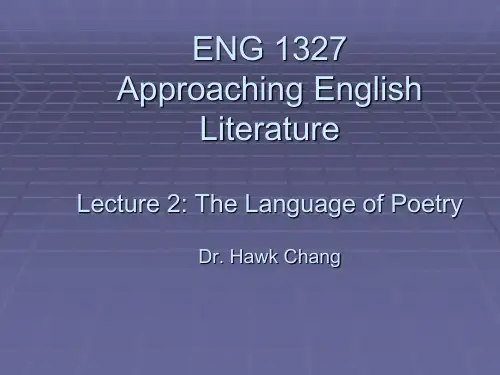
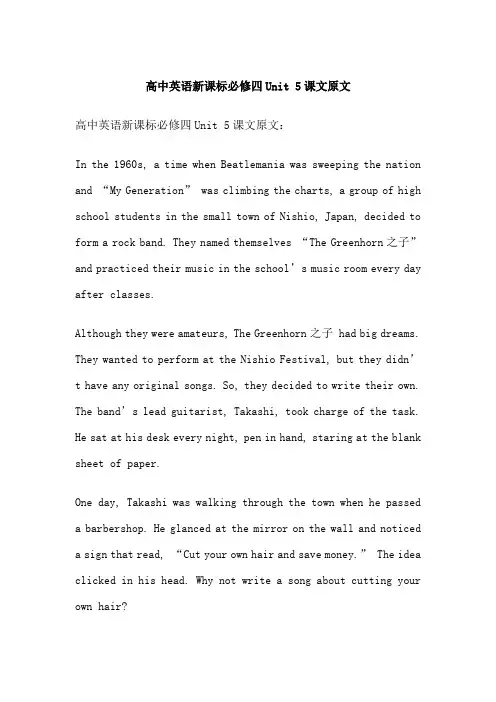
高中英语新课标必修四Unit 5课文原文高中英语新课标必修四Unit 5课文原文:In the 1960s, a time when Beatlemania was sweeping the nation and “My Generation” was climbing the charts, a group of high school students in the small town of Nishio, Japan, decided to form a rock band. They named themselves “The Greenhorn之子”and practiced their music in the school’s music room every day after classes.Although they were amateurs, The Greenhorn之子 had big dreams. They wanted to perform at the Nishio Festival, but they didn’t have any original songs. So, they decided to write their own. The band’s lead guitarist, Takashi, took charge of the task. He sat at his desk every night, pen in hand, staring at the blank sheet of paper.One day, Takashi was walking through the town when he passed a barbershop. He glanced at the mirror on the wall and noticed a sign that read, “Cut your own hair and save money.” The idea clicked in his head. Why not write a song about cutting your own hair?Back at the band’s practice space, Takashi and the other band members brainstormed ideas. They came up with the chorus: “Cut your own hair / Do it yourself / Save money / Be a man!” They wrote the verses and filled in the bridge, creating a catchy tune that everyone could sing along to.The Greenhorn之子 performed their new song at the Nishio Festival and received a standing ovation. They had achieved their dream and more. Their catchy tune became popular all over Japan and even beyond, resonating with young people who shared their independent spirit.In the end, The Greenhorn之子 didn’t become rock stars, but their legacy lives on in the song they wrote together. It serves as a reminder that with a little creativity and self-reliance, anyone can accomplish their goals, no matter how big or small. 关键词: Greenhorn之子、摇滚乐队、原创歌曲、Takashi、镇上的理发店、自己剪头发、脑暴、Nishio Festival、独立精神、legacy、创造力、自立内容分析:这篇文章讲述了20世纪60年代日本一个高中摇滚乐队The Greenhorn之子如何通过自己创作歌曲并最终在音乐节上获得成功的经历。
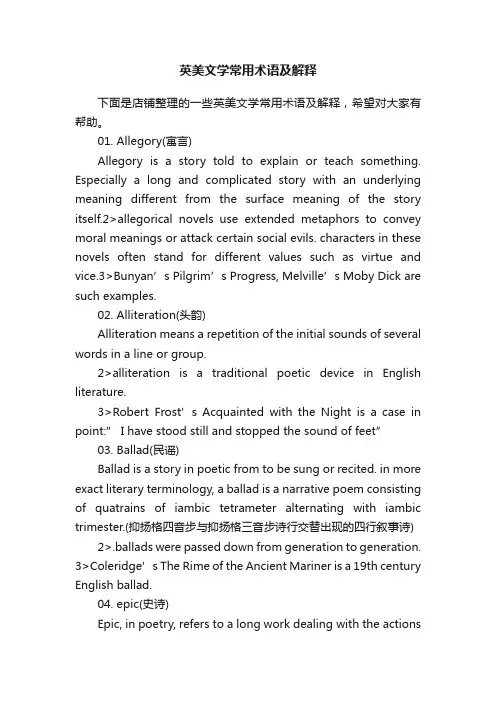
英美文学常用术语及解释下面是店铺整理的一些英美文学常用术语及解释,希望对大家有帮助。
01. Allegory(寓言)Allegory is a story told to explain or teach something. Especially a long and complicated story with an underlying meaning different from the surface meaning of the story itself.2>allegorical novels use extended metaphors to convey moral meanings or attack certain social evils. characters in these novels often stand for different values such as virtue and vice.3>Bunyan’s Pilgrim’s Progress, Melville’s Moby Dick are such examples.02. Alliteration(头韵)Alliteration means a repetition of the initial sounds of several words in a line or group.2>alliteration is a traditional poetic device in English literature.3>Robert Frost’s Acq uainted with the Night is a case in point:” I have stood still and stopped the sound of feet”03. Ballad(民谣)Ballad is a story in poetic from to be sung or recited. in more exact literary terminology, a ballad is a narrative poem consisting of quatrains of iambic tetrameter alternating with iambic trimester.(抑扬格四音步与抑扬格三音步诗行交替出现的四行叙事诗)2>.ballads were passed down from generation to generation.3>Coleridge’s The Rime of the Ancient Mariner is a 19th century English ballad.04. epic(史诗)Epic, in poetry, refers to a long work dealing with the actionsof goods and heroes.2>Epic poems are not merely entertaining stories of legendary or historical heroes; they summarize and express the nature or ideals of an entire nation at a significant or crucial period of its history.3>Beowulf is the greatest national Epic of the Anglo-Saxons.05. Lay(短叙事诗)It is a short poem, usually a romantic narrative, intended to be sung or recited by a minstrel.06. Romance(传奇)Romance is a popular literary form in the medic England.2>it sings knightly adventures or other heroic deeds.3>chivalry is the spirit of the romance.07. Alexandrine(亚历山大诗行)The name is derived from the fact that certain 12th and 13th century French poems on Alexander the Great were written in this meter.2>it is an iambic line of six feet, which is the French heroic verse.08. Blank Verse(无韵诗或素体广义地说)Blank verse is unrhymed poetry. Typically in iambic pentameter, and as such, the dominant verse forms of English dramatic and narrative poetry since the mid-16th century.09. Comedy(喜剧)Comedy is a light form of drama that aims primarily to amuse and that ends happily. Since it strives to provoke smile and laughter, both wit and humor are utilized. In general, the comic effect arises from recognition of some incongruity of speech, action, or character revelation, with intricate plot.10. Essay(随笔)The term refers to literary composition devoted to the presentation of the writer’s own ideas on a topic and generally addressing a particular aspect of the subject. Often brief in scope and informal in style, the essay differs from such fomal forms as the thesis, dissertation or treatise.11. Euphuistic style(绮丽体)Its principle characteristics are the excessive use of antithesis, which is pursued regardless of sense, and emphasized by alliteration and other devices; and of allusions to historical and mythological personages and to natural history drawn from such writers as Plutarch(普卢塔克), Pliny(普林尼), and Erasmus(伊拉兹马斯).2>it is the peculiar style of Euphues(优浮绮斯)12. History Plays(历史剧)History plays aim to present some historical age or character, and may be either a comedy or a tragedy. They almost tell stories about the nobles, the true people in history, but not ordinary people. the principle idea of Shakespeare’s history plays is the necessity for national unity under a mighty and just sovereign.13. Masques or Masks(假面剧)Masques (or Masks) refer to the dramatic entertainments involving dances and disguises, in which the spectacular and musical elements predominated over plot and character. As they were usually performed at court, often at very great expense, many have political overtones.14. Morality plays(道德剧)A kind of medic and early Renaissance drama that presents the conflict between the good and evil through allegorical characters. The characters tend to be personified abstractions of vices and virtues, which can be named as Mercy. Conscience, etc. unlike a mystery or a miracle play, morality play does notnecessarily use Biblical or strictly religious material because it takes place internally and psychologically in every human being.15.Sonnet(十四行诗)It is a lyric poem of 14 lines with a formal or recited and characterized by its presentation of a dramatic or exciting episode in simple narrative form.2>it is one of the most conventional and influential forms of poetry in Europe.3>Shakespeare’s sonnets are well-known.16. Spenserian Stanza(斯宾塞诗节)Spenserian Stanza is the creation of Edmund spenser.2>it refers to a stanza of nine lines, with the first eight lines in iambic pentameter(五音步抑扬格) and the last line in iambic hexameter(六音步抑扬格),rhyming ababbcbcc. 3>Spenser’s the Faerie Queen was written in this kind of stanza.17. Stanza(诗节)Stanza is a group of lines of poetry, usually four or more, arranged according to a fixed plan.2>the stanza is the unit of structure in a poem and poets do not vary the unit within a poem.18. Three Unities(三一原则)Three rules of 16th and 17th century Italian and French drama, broadly adapted from Aristotle’s Poetics<诗学>:2>the unity of time, which limits a play to a single day; the unity of place, which limits a play’s setting in a single location; and the unity of action, which limits a play to a single story line.19. Tragedy(悲剧)In general, a literary work in which the protagonist meets an unhappy or disastrous end. Unlike comedy, tragedy depicts the actions of a central character who is usually dignified or heroic.20.Conceit(奇特比喻)Conceit is a far-fetched simile or metaphor, a literary conceit occurs when the speaker compares two highly dissimilar things.2>conceit is extensively employed in John Donne’s poetry.21.Metar(格律)The word”meter” is derived from the Greek word”metron” meaning”measure”.2>in English when applied to poetry, it refers to the regular pattern of stressed and unstressed syllables.3>the analysis of the meter is called scansion(格律分析)22. University Wits(大学才子)University Wits refer to a group of scholars during the Elizabethan Age who graduated from either oxford or Cambridge. They came to London with the ambition to become professional writers. Some of them later became famous poets and playwrights. They were called” University Wits”23.Foreshadowing(预兆)Foreshadowing, the use of hints or clues in a novel or drama to suggest what will happen next. Writers use Foreshadowing to create interest and to build suspense.method used to build suspense by providing hints of what is to come.24. Soliloquy(独白)Soliloquy, in drama, means a moment when a character is alone and speaks his or her thoughts aloud..2>the line“to be, or no t to be, that is the question”, which begins the famous soliloquy from Shakespeare’s Hamlet.25.Narrative Poem(叙述诗)Narrative Poem refers to a poem that tells a story in verse,2>three traditional types of narrative poems include ballads,epics, metrical romances.3>it may consist of a series of incidents, as John Milton’s paradise lost.26.Robin Hood(罗宾.豪)Robin hood is a legendary hero of a series of English ballads, some of which date from at least the 14th century.2>the character of Robin Hood is many-sided. Strong, brave and intelligent, he is at the same time tender-hearted and affectionate.3>the dominant key in his character is his hatred for the cruel oppression and his love for the poor and downtrodden.4>another feature of Robin’s view is his reverence for the king, Robin Hood was a people’s hero.27. Beowulf(贝奥武甫)Beowulf, a typical example of old English poetry, is regarded as the greatest national epic of t he Anglo-Saxons. 2>the epic describes the exploits of a Scandinavian hero, Beowulf, in fighting against the monster Grendel, his revengeful nother, and a fire-breathing dragon in his declining years. While fight against the dragon, Beowulf was mortally wounded, however, he killed the dragon at the cost of his life, Beowulf is shown not only as a glorious hero but also as a protector of the people.28. Baroque(巴罗克式风格)This is originally a term of abuse applied to 17th century Italian art and that of other countries. It is characterized by the unclassical use of classical forms, in a literary context; it is loosely used to describe highly ornamented verse or prose, abounding in extravagant conceits.这原本是用来指17世纪的意大利艺术和其他国家艺术滥用的一个术语.这种风格主要是指对古典形式的非古典运用.在文学领域,这种风格松散地用来指十分雕饰的,大量运用奇思妙想的诗歌或散文.29. Cavalier poets(骑士派诗人)A name given to supporters of Charles I in the civil war. These poets were not a formal group, but all influenced by Ben Jonson and like him paid little attention to the sonnet. Their lyrics are distinguished by short lines, precise but idiomatic diction, and an urbane and graceful wit.30. Elegy(挽歌)Elegy has typically been used to refer to reflective poems that lament the loss of something or someone, and characterized by their metrical form.31. Restoration Comedy(复辟时期喜剧)Restoration Comedy, also the comedy of manners, developed upon the reopening of the theatres after the re-establishment of monarchy with the return of Charles II.. Its predominant tone was witty, bawdy, cynical, and amoral. Standard characters include fops, bawds, scheming valets, country squires, and sexually voracious young widows and older women. The principle theme is sexual intrigue, either for its own sake or for money.复辟时期的喜剧,又称社会习俗讽刺喜剧,是在查理二世君主复辟后剧院重新开业的基础上发展起来的,其主要的基调是诙谐,淫秽,挖苦和非道德.标准的角色包括花花公子,鸨母,诡计多端的仆人,乡绅,性欲旺盛的年轻寡妇和老女人.主要的主题是奸情,有的是为了性,有的是为了钱.。
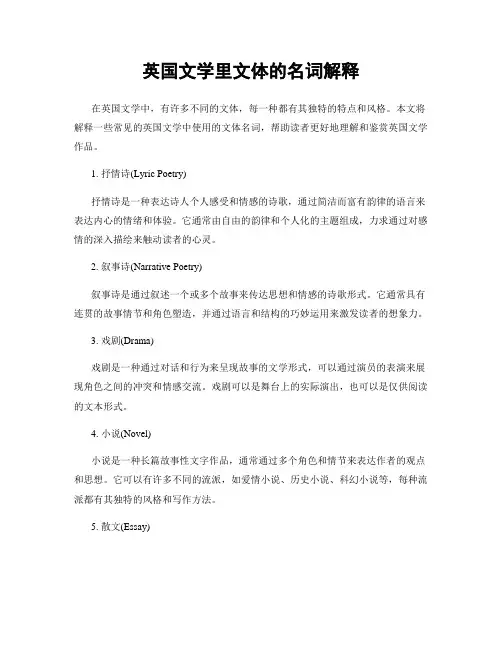
英国文学里文体的名词解释在英国文学中,有许多不同的文体,每一种都有其独特的特点和风格。
本文将解释一些常见的英国文学中使用的文体名词,帮助读者更好地理解和鉴赏英国文学作品。
1. 抒情诗(Lyric Poetry)抒情诗是一种表达诗人个人感受和情感的诗歌,通过简洁而富有韵律的语言来表达内心的情绪和体验。
它通常由自由的韵律和个人化的主题组成,力求通过对感情的深入描绘来触动读者的心灵。
2. 叙事诗(Narrative Poetry)叙事诗是通过叙述一个或多个故事来传达思想和情感的诗歌形式。
它通常具有连贯的故事情节和角色塑造,并通过语言和结构的巧妙运用来激发读者的想象力。
3. 戏剧(Drama)戏剧是一种通过对话和行为来呈现故事的文学形式,可以通过演员的表演来展现角色之间的冲突和情感交流。
戏剧可以是舞台上的实际演出,也可以是仅供阅读的文本形式。
4. 小说(Novel)小说是一种长篇故事性文字作品,通常通过多个角色和情节来表达作者的观点和思想。
它可以有许多不同的流派,如爱情小说、历史小说、科幻小说等,每种流派都有其独特的风格和写作方法。
5. 散文(Essay)散文是一种以个人观点和思考为主的文学形式,通常采用散文体和杂文体的结构。
它可以用于表达个人见解、观点和对世界的观察,更注重思辨和论证,而不是叙述故事。
6. 传记(Biography)传记是一种以真实人物生平和经历为基础的文学形式,通过对人物的描写和解读,展示其对历史和社会的影响。
传记可以提供对个人生活和职业生涯的详尽了解,使读者更深入地了解人物的个性和成就。
7. 报告文学(Creative Nonfiction)报告文学是一种将事实与文学元素结合的非虚构写作形式,通过文学手法和叙事技巧,呈现真实事件和人物的故事。
它既有文学的艺术性,又具备对历史、文化和社会的记载和呈现。
8. 日记(Diary)日记是一种通过记录个人生活、观察和思考,来表达作者内心世界的文学形式。
九年级诗歌欣赏英语阅读理解25题1<背景文章>Poetry has always been a beautiful form of art that can touch our hearts and souls. One of the most famous poets is William Shakespeare. His sonnets are renowned for their deep themes, vivid imagery, and perfect rhyme schemes.Let's take a closer look at Sonnet 18: 'Shall I compare thee to a summer's day? Thou art more lovely and more temperate. Rough winds do shake the darling buds of May, And summer's lease hath all too short a date. Sometime too hot the eye of heaven shines, And often is his gold complexion dimmed; And every fair from fair sometime declines, By chance or nature's changing course untrimmed; But thy eternal summer shall not fade, Nor lose possession of that fair thou ow'st; Nor shall Death brag thou wander'st in his shade, When in eternal lines to time thou grow'st. So long as men can breathe or eyes can see, So long lives this, and this gives life to thee.'The theme of this sonnet is the eternal beauty of the beloved. Shakespeare compares the beloved to a summer's day but then goes on to say that the beloved is even more beautiful and lasting. The imagery of summer, with its warm days and blooming flowers, is vividly portrayed.The rhyme scheme of the sonnet is abab cdcd efef gg, which gives it a musical quality.Now let's analyze some of the elements of this sonnet. The use of personification in 'Rough winds do shake the darling buds of May' makes the winds seem more alive and powerful. The line 'And every fair from fair sometime declines' shows the transient nature of beauty. However, the idea that the beloved's beauty is eternal is a powerful contrast.1. What is the theme of Sonnet 18?A. The power of nature.B. The beauty of summer.C. The eternal beauty of the beloved.D. The sadness of love.答案:C。
英文诗体裁泰戈尔
泰戈尔的英文诗体裁主要有以下几种:
1.自由诗(Free Verse):泰戈尔的许多英文诗使用了自由诗的形式,也就是没有固定的诗歌结构和韵律模式。
这种形式的诗歌更加注重灵感、表达和意象,不受传统形式的束缚。
2.抒情诗(Lyric Poetry):泰戈尔的很多英文诗都是抒发情感和个人体验的抒情诗。
他通过深情、感人的语言表达自己对自然、爱情、人生和宗教的思考和感受。
3.叙事诗(Narrative Poetry):尽管泰戈尔的英文诗以抒情诗居多,但也有少数叙事诗作品。
这些诗歌讲述了一些具体的故事或者描述了一段经历,以叙述为主,给读者带来视觉和情感上的享受。
4.哲理诗(Philosophical Poetry):泰戈尔的英文诗经常包含着深刻的哲理和思考。
他用简练而有力的语言表达对人生、命运和道德的思考,引发读者对人类存在和意义的思考。
5.神秘主义诗(Mystical Poetry):泰戈尔的一些英文诗作品探索了宇宙、灵性和神秘的主题。
他通过抽象的意象和哲思表达了对宇宙力量和灵魂深处的探求。
总的来说,泰戈尔的英文诗以抒情诗为主,同时融入了自由诗、叙事诗、哲理诗和神秘主义诗的元素。
他的诗歌语言流畅、感人,深刻地体现了对爱、自然、人生和灵性的思考。
常见的英语诗歌类型包括以下几种:
1. 叙事诗(Narrative Poetry):叙事诗通常讲述一个完整的故事,以叙事为主,强调情节和人物塑造。
例如,《罗密欧与朱丽叶》等。
2. 抒情诗(Lyric Poetry):抒情诗通常以情感表达为主,通常描述个人情感和内心世界。
例如,威廉·莎士比亚的许多诗歌都属于抒情诗范畴。
3. 格律诗(Metered Poetry):格律诗通常遵循一定的节奏和韵律,例如,五步抑扬格、四步抑扬格等。
例如,约翰·弥尔顿的《失乐园》等。
4. 自由诗(Free Verse):自由诗不受传统诗歌形式的限制,可以自由表达,没有固定的节奏和韵律。
例如,埃兹拉·庞德的诗歌等。
5. 讽刺诗(Satirical Poetry):讽刺诗通常以幽默或嘲讽的方式对某人或某事进行批评或调侃。
例如,约翰·贝杰曼的《乔治·华盛顿》等。
6. 哲理诗(Philosophical Poetry):哲理诗通常探讨人生、宇宙、伦理等哲学问题,以深刻的思考和洞见为特点。
例如,约翰·多恩的《没有人是一座孤岛》等。
7. 童话诗(Fairy Tale Poetry):童话诗通常基于童话故事或神话传说,具有丰富的想象力和奇幻色彩。
例如,《彼得·潘》等。
8. 寓言诗(Fable Poetry):寓言诗通常通过讲述动物或其他虚构人物的故事来传达某种道德或教训。
例如,《狐狸和葡萄》等。
常见的英语诗歌类型英语诗歌是世界文学中的瑰宝,它以其独特的表现形式和丰富的意境深受读者喜爱。
在英语诗歌的世界中,存在着多种类型的诗歌。
本文将介绍常见的英语诗歌类型,包括抒情诗、叙事诗、讽刺诗和随笔诗。
抒情诗(Lyric Poetry)抒情诗是最常见的诗歌类型之一,它以表达诗人内心感受和情感为主要特点。
抒情诗往往采用自由的韵律和押韵方式,通过诗人细腻的表达和生动的形象描绘,传递出强烈的情感共鸣。
例如,英国著名诗人威廉·莎士比亚的 sonnet(十四行诗)就是一种典型的抒情诗形式。
叙事诗(Narrative Poetry)叙事诗是一种通过讲述故事来传达情感和思想的诗歌形式。
它以故事的发展和情节的推进为主要特点。
叙事诗通常使用较为规范的韵律和押韵方式,通过生动的描写和悬念的设置,吸引读者的注意力。
著名的叙事诗包括约翰·米尔顿的《失乐园》和亨利·朗费罗的《荷马尼迦的歌谣》。
讽刺诗(Satirical Poetry)讽刺诗是一种通过嘲笑、讽刺和调侃来表达对社会问题或个人缺点的诗歌形式。
讽刺诗往往运用幽默的手法和夸张的语气,通过对现实的批判和讽刺,来引起读者的思考和反思。
著名的讽刺诗人乔纳森·斯威夫特的《格利佛游记》就是一部典型的讽刺诗歌作品。
随笔诗(Prose Poetry)随笔诗是一种介于散文和诗歌之间的文体形式。
它以自由的表达方式和抒发情感的特点,不受传统诗歌形式的限制。
随笔诗通常运用简洁而朴素的语言,通过富有思想性和抒情性的叙述,呈现出作者独特的观察和感悟。
著名的现代诗人艾米丽·迪金森的诗歌就常常采用随笔诗形式。
总结以上介绍了常见的英语诗歌类型,包括抒情诗、叙事诗、讽刺诗和随笔诗。
每一种诗歌形式都有其独特的表达方式和特点,通过不同的形式和风格,诗人们把个人的情感、思想和观察融入到诗歌中,创造出美丽而有力的作品。
阅读和欣赏这些不同类型的诗歌,不仅能够感受到诗歌的美感,还能够从中体会到作者情感和思想的传达。
Poetry is a form of literature that uses aesthetic and rhythmic qualities of language—such as phonaesthetics, sound symbolism, and metre—to evoke meanings in addition to, or in place of, the prosaic ostensible meaning.Poetry has a long history, dating back to the Sumerian Epic of Gilgamesh. Early poems evolved from folk songs such as the Chinese Shijing, or from a need to retell oral epics, as with the Sanskrit Vedas(吠陀经), Zoroastrian Gathas(索罗亚斯德教的《迦特》), and the Homeric epics, the Iliad and the Odyssey. Ancient attempts to define poetry, such as Aristotle's Poetics, focused on the uses of speech in rhetoric, drama, song and comedy. Later attempts concentrated on features such as repetition, verse form and rhyme, and emphasized the aesthetics which distinguish poetry from more objectively informative, prosaic forms of writing. From the mid-20th century, poetry has sometimes been more generally regarded as a fundamental creative act employing language.Poetry uses forms and conventions to suggest differential interpretation to words, or to evoke emotive responses. Devices such as assonance(类韵,谐音), alliteration, onomatopoeia and rhythm are sometimes used to achieve musical or incantatory(咒语的,魔咒的)effects. The use of ambiguity, symbolism, irony and other stylistic elements of poetic diction often leaves a poem open to multipleinterpretations. Similarly figures of speech such as metaphor, simile and metonymy(转喻)create a resonance(共鸣,反响)between otherwise disparate images—a layering of meanings, forming connections previously not perceived. Kindred(相似的,亲属关系)forms of resonance may exist, between individual verses, in their patterns of rhyme or rhythm.Some poetry types are specific to particular cultures and genres and respond to characteristics of the language in which the poet writes. Readers accustomed to identifying poetry with Dante, Goethe, and Rumi may think of it as written in lines based on rhyme and regular meter; there are, however, traditions, such as Biblical poetry, that use other means to create rhythm and euphony(悦耳之音). Much modern poetry reflects a critique of poetic tradition, playing with and testing, among other things, the principle of euphony itself, sometimes altogether forgoing(放弃,停止)rhyme or set rhythm. In today's increasingly globalized world, poets often adapt forms, styles and techniques from diverse cultures and languages.HISTORYPoetry as an art form may predate literacy. Epic poetry, from the Indian Vedas(1700–1200 BC) and Zoroaster's Gathas to the Odyssey (800–675 BC), appears to have been composed in poetic form to aidmemorization and oral transmission, in prehistoric and ancient societies. Other forms of poetry developed directly from folk songs. The earliest entries in the ancient compilation Shijing, were initially lyrics, preceding later entries intended to be read.The oldest surviving epic poem is the Epic of Gilgamesh, from the 3rd millennium BC in Sumer (in Mesopotamia, now Iraq), which was written in cuneiform(楔形文字)script on clay tablets and, later, papyrus (纸沙草). Other ancient epic poetry includes the Greek epics Iliad and Odyssey, the Old Iranian books the Gathic Avesta and Yasna, the Roman national epic, Virgil's Aeneid(埃涅依德), and the Indian epics Ramayana (罗摩传)and Mahabharata(摩诃婆罗多).The efforts of ancient thinkers to determine what makes poetry distinctive as a form, and what distinguishes good poetry from bad, resulted in "poetics"—the study of the aesthetics of poetry. Some ancient poetic traditions; such as, contextually, Classical Chinese poetry in the case of the Shijing (Classic of Poetry), which records the development of poetic canons(真作,真经)with ritual and aesthetic importance. More recently, thinkers have struggled to find a definition that could encompass formal differences as great as those between Chaucer's Canterbury Tales and Matsuo Bashō's(松尾芭蕉)Oku no Hosomichi(奥之细道), as wellas differences in context spanning Tanakh(希伯来圣经)religious poetry, love poetry, and rap.GenresA poetic genre is generally a tradition or classification of poetry based on the subject matter, style, or other broader literary characteristics. Some commentators view genres as natural forms of literature. Others view the study of genres as the study of how different works relate and refer to other works.Narrative poetryNarrative poetry is a genre of poetry that tells a story. Broadly it subsumes epic poetry, but the term "narrative poetry" is often reserved for smaller works, generally with more appeal to human interest. Narrative poetry may be the oldest type of poetry. Many scholars of Homer have concluded that his Iliad and Odyssey were composed from compilations of shorter narrative poems that related individual episodes. Much narrative poetry—such as Scottish and English ballads, and Baltic(波罗的海)and Slavic(斯拉夫语的)heroic poems—is performance poetry with roots in a preliterate oral tradition. It has been speculated that some features that distinguish poetry from prose, such as meter, alliteration and kennings, once served as memory aids for bards(吟游诗人)who recitedtraditional tales.Notable narrative poets have included Ovid, Dante, Juan Ruiz, Chaucer, William Langland, Luís de Camões, Shakespeare, Alexander Pope, Robert Burns, Fernando de Rojas, Adam Mickiewicz, Alexander Pushkin, Edgar Allan Poe and Alfred Tennyson.Epic poetryEpic poetry is a genre of poetry, and a major form of narrative literature. This genre is often defined as lengthy(漫长的,冗长的)poems concerning events of a heroic or important nature to the culture of the time. It recounts, in a continuous narrative, the life and works of a heroic or mythological person or group of persons. Examples of epic poems are Homer's Iliad and Odyssey, Virgil's Aeneid, the Nibelungenlied,Luís de Camões' Os Lusíadas, the Cantar de Mio Cid, the Epic of Gilgamesh, the Mahabharata, Valmiki's Ramayana, Ferdowsi's Shahnama, Nizami (or Nezami)'s Khamse (Five Books), and the Epic of King Gesar. While the composition of epic poetry, and of long poems generally, became less common in the west after the early 20th century, some notable epics have continued to be written. Derek Walcott won a Nobel prize to a great extent on the basis of his epic, Omeros.Dramatic poetryDramatic poetry is drama written in verse to be spoken or sung, and appears in varying, sometimes related forms in many cultures. Greek tragedy in verse dates to the 6th century B.C., and may have been an influence on the development of Sanskrit drama, just as Indian drama inturn appears to have influenced the development of the bianwen verse dramas in China, forerunners of Chinese Opera. East Asian verse dramas also include Japanese Noh(能剧). Examples of dramatic poetry in Persian literature include Nizami's two famous dramatic works, Layla and Majnun and Khosrow and Shirin, Ferdowsi's tragedies such as Rostam and Sohrab, Rumi's Masnavi, Gorgani's tragedy of Vis and Ramin, and Vahshi's tragedy of Farhad.Satirical poetryPoetry can be a powerful vehicle for satire. The Romans had a strong tradition of satirical poetry, often written for political purposes. A notable example is the Roman poet Juvenal's satires.The same is true of the English satirical tradition. John Dryden (a Tory), the first Poet Laureate, produced in 1682 Mac Flecknoe, subtitled "A Satire on the True Blue Protestant Poet, T.S." (a reference to Thomas Shadwell). Another master of 17th-century English satirical poetry was John Wilmot, 2nd Earl of Rochester. Satirical poets outside England include Poland's Ignacy Krasicki, Azerbaijan's Sabir and Portugal's Manuel Maria Barbosa du Bocage.Light poetryLight poetry, or light verse, is poetry that attempts to be humorous.Poems considered "light" are usually brief, and can be on a frivolous(无聊的,琐碎的)or serious subject, and often feature word play, including puns, adventurous rhyme and heavy alliteration. Although a few free verse poets have excelled at light verse outside the formal verse tradition, light verse in English is usually formal. Common forms include the limerick(五行打油诗), the clerihew(克莱里休四行打油诗), and the double dactyl(扬抑抑格).While light poetry is sometimes condemned as doggerel(打油诗), or thought of as poetry composed casually, humor often makes a serious point in a subtle or subversive(破坏性的,颠覆的)way. Many of the most renowned "serious" poets have also excelled at light verse. Notable writers of light poetry include Lewis Carroll, Ogden Nash, X. J. Kennedy, Willard R. Espy, and Wendy Cope.Lyric poetry (抒情诗)Lyric poetry is a genre that, unlike epic and dramatic poetry, does not attempt to tell a story but instead is of a more personal nature. Poems in this genre tend to be shorter, melodic, and contemplative(沉思的,冥想的). Rather than depicting characters and actions, it portrays the poet's own feelings, states of mind, and perceptions. Notable poets in this genre include John Donne, Gerard Manley Hopkins, and Antonio Machado.Elegy (挽歌)An elegy is a mournful, melancholy or plaintive(哀伤的)poem, especially a lament for the dead or a funeral song. The term "elegy," which originally denoted a type of poetic meter (elegiac meter), commonly describes a poem of mourning. An elegy may also reflect something that seems to the author to be strange or mysterious. The elegy, as a reflection on a death, on a sorrow more generally, or on something mysterious, may be classified as a form of lyric poetry.Notable practitioners of elegiac poetry have included Propertius, Jorge Manrique, Jan Kochanowski, Chidiock Tichborne, Edmund Spenser, Ben Jonson, John Milton, Thomas Gray, Charlotte Turner Smith, William Cullen Bryant, Percy Bysshe Shelley, Johann Wolfgang von Goethe, Evgeny Baratynsky, Alfred Tennyson, Walt Whitman, Louis Gallet, Antonio Machado, Juan Ramón Jiménez, William Butler Yeats, Rainer Maria Rilke, and Virginia Woolf.Verse fable (寓言诗)The fable is an ancient literary genre, often (though not invariably) set in verse. It is a succinct(简洁的)story that features anthropomorphized animals, plants, inanimate objects, or forces of nature that illustrate a moral lesson (a "moral"). Verse fables have used a variety of meter and rhyme patterns.Notable verse fabulists have included Aesop, Vishnu Sarma, Phaedrus, Marie de France, Robert Henryson, Biernat of Lublin, Jean de La Fontaine, Ignacy Krasicki, Félix María de Samaniego, Tomás de Iriarte, Ivan Krylov and Ambrose Bierce.Prose poetry (散文诗)Prose poetry is a hybrid(混合的)genre that shows attributes of both prose and poetry. It may be indistinguishable from the micro-story (a.k.a. the "short short story", "flash fiction"). While some examples of earlier prose strike modern readers as poetic, prose poetry is commonly regarded as having originated in 19th-century France, where its practitioners included Aloysius Bertrand, Charles Baudelaire, Arthur Rimbaud and Stéphane Mallarmé. Since the late 1980s especially, prose poetry has gained increasing popularity, with entire journals, such as The Prose Poem: An International Journal, Contemporary Haibun Online devoted to that genre.Speculative poetrySpeculative poetry, also known as fantastic poetry, (of which weird or macabre(可怕的,以死亡为主题的)poetry is a major subclassification), is a poetic genre which deals thematically with subjects which are 'beyond reality', whether via extrapolation as inscience fiction or via weird and horrific themes as in horror fiction. Such poetry appears regularly in modern science fiction and horror fiction magazines. Edgar Allan Poe is sometimes seen as the "father of speculative poetry".。
Narrative poetryNarrative poetry is poetry that tells a story. In its broadest sense, it includes epic poetry; some would reserve the name narrative poetry for works on a smaller scale and generally with more direct appeal to human interest than the epic.Narrative poetry is among the oldest, and perhaps the oldest, genre of poetry. Many scholars of Homer, from Quintus Smyrnaeus forward, have concluded that his tales of the Iliad and Odyssey were composed from compilations of shorter narrative poems that related individual episodes, and which were more suitable for an evening's entertainment. Much of narrative poetry is performance poetry and has its source in an oral tradition: the Scots and English ballads, the tales of Robin Hood, of Iskandar, and various Baltic and Slavic heroic poems all were originally intended for recitation, rather than reading. In many cultures, there remains a lively tradition of the recitation of traditional tales in verse form. Some have speculated that some of the distinctive features that distinguish poetry from prose, such as metre, alliteration, and , at one time served as memory aids that allowed the bards who recited traditional tales to reconstruct them from memory.Some narrative poetry takes the form of a novel in verse. An example of this is The Ring and the Book by Robert Browning. In terms of narrative poetry, a romance is a narrative poem that tells a story of chivalry. Examples include the Romance of the Rose or Tennyson's Idylls of the King. Although these examples use medieval and Arthurian materials, romances may also tell stories from classical mythology.Shorter narrative poems are often similar in style to the short story. Sometimes, these short narratives are collected into interrelated groups, as with Chaucer's Canterbury Tales.The most popular form of narrative poetry is probably the ballad. Originally intended to be sung while dancing, ballads have enjoyed a revival since the 1950s as part of the general revival of interest in folk music. The broadsheet ballad was a form of narrative poetry that took the form of the folk ballad and recast it in printed form. These often related an event of interest such as a crime, and were used to spread the news of that event. They often added moralistic, comic, or other editorial comments to the events they narrated. The broadsheet ballad is associated with England from the introduction of printing to the invention of the first newspapers.Characterization is the process of creating characters in fiction, often those who are different from and have different beliefs than the author. A writer can assume the point of view of a child, an older person, a member of the opposite gender, someone of another race or culture, or anyone who isn't like them in personality or otherwise. Thorough characterization makes characters well-rounded and complex even thoughthe writer may not be like the character or share his or her attitudes and beliefs. This allows for a sense of realism. For example, according to F.R. Leavis, Leo Tolstoy was the creator of some of the most complex and psychologically believable characters in fiction.Characterization can involve developing a variety of aspects of a character, such as appearance, age, gender, educational level, vocation or occupation, financial status, marital status, social status, hobbies, sexual orientation, religious beliefs, ambitions, motivations, etc. According to the Shreklisch Onion Layer Model, the psychological makeup of a fully developed storybook character involves fears, emotions, back-story, issues, beliefs, practices, desires, and intentions. Often these can be shown through the actions and language of the character, rather than by telling the reader directly.In fan fiction, thorough characterization is not usually necessary since a writer is using characters already familiar to the reader. An exception is in stories set in alternative universes, which may significantly change the personalities of characters established by others, and directly revealing details may be necessary to avoid reader confusion or to warn the reader of settings he or she may not like.In essays or novels, characterization is character development, which helps to establish themes.Characterization can be presented either directly or indirectly. Direct characterization takes place when the author literally tells the audience what a character is like. In indirect characterization, the audience must deduce for themselves what the character is like through the character's thoughts, actions, speech, looks and interaction with other characters.motivation refers to the initiation, direction, intensity and persistence of behavior (Geen, 1995). Motivation is a temporal and dynamic state that should not be confused with personality or emotion. Motivation is having the desire and willingness to do something. A motivated person can be reaching for a long-term goal such as becoming a professional writer or a more short-term goal like learning how to spell a particular word. Personality invariably refers to more or less permanent characteristics of an individual's state of being (e.g., shy, extrovert, conscientious). As opposed to motivation, emotion refers to temporal states that do not immediately link to behavior (e.g., anger, grief, happiness).Narration is, simply put, the art of "telling back" what has been learned. Narration refers to the way that a story is told, and so belongs to the level of discourse (although in first-person narration it may be that the narrator also plays a role in the development of the story itself). The different kinds of narration are categorized by each one's primary grammatical stance: either 1) the narrator speaks from within the story and, so, uses "I" to refer to him- or herself (see first-person narration); in other words, the narrator is a character of some sort in the story itself, even if he is only apassive observer; or 2) the narrator speaks from outside the story and never employs the "I" (see third-person narration).。